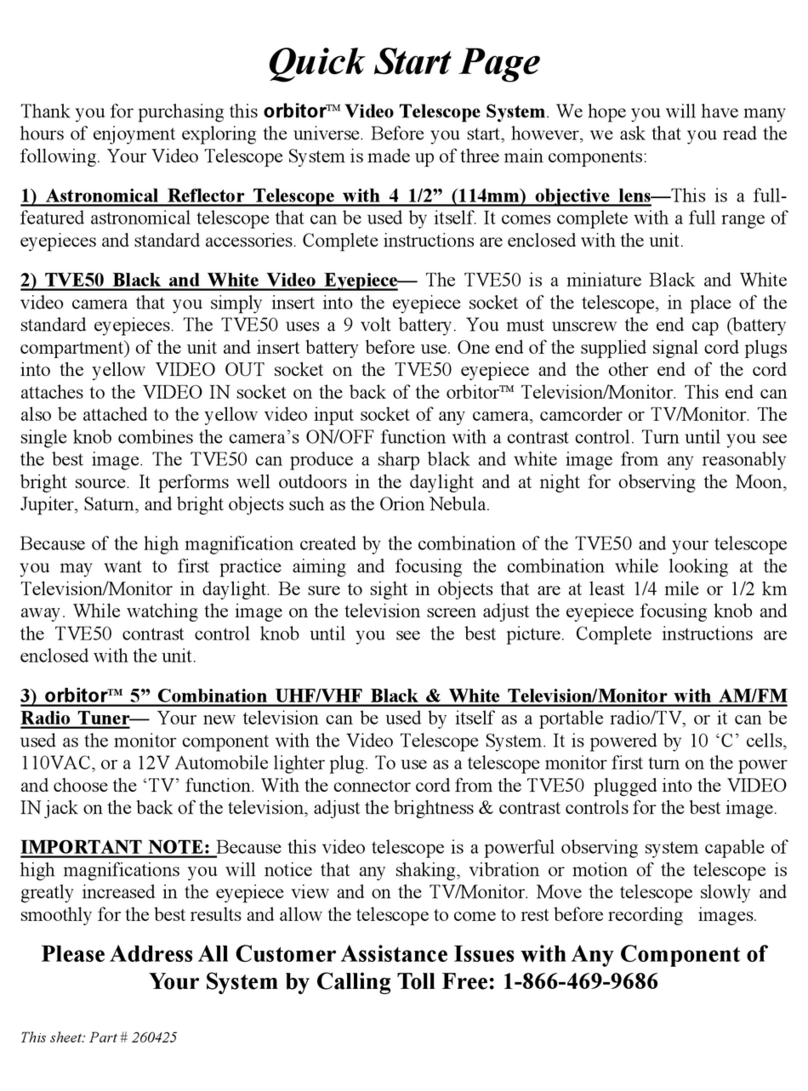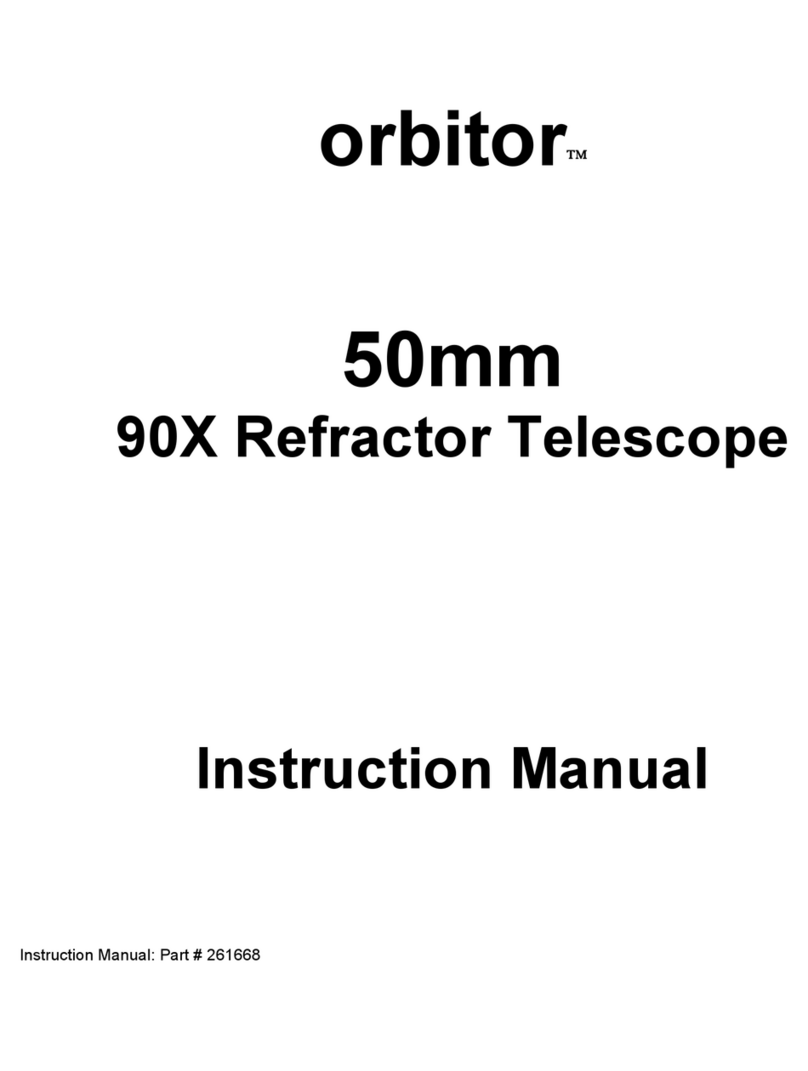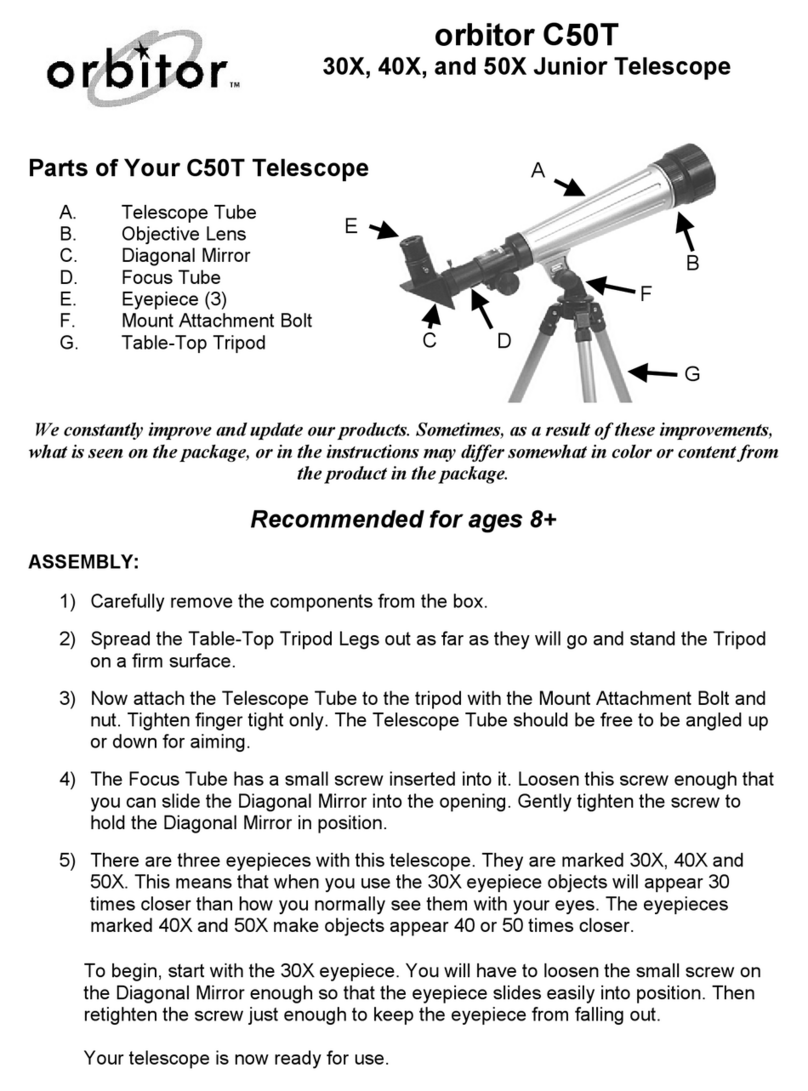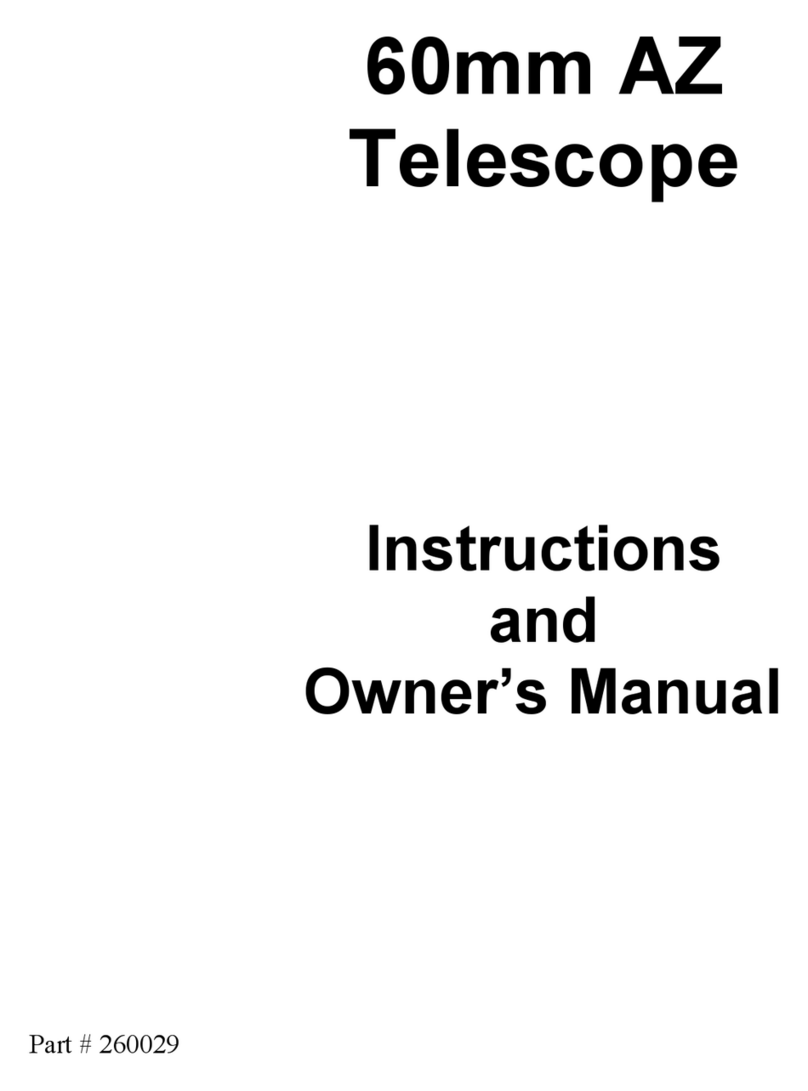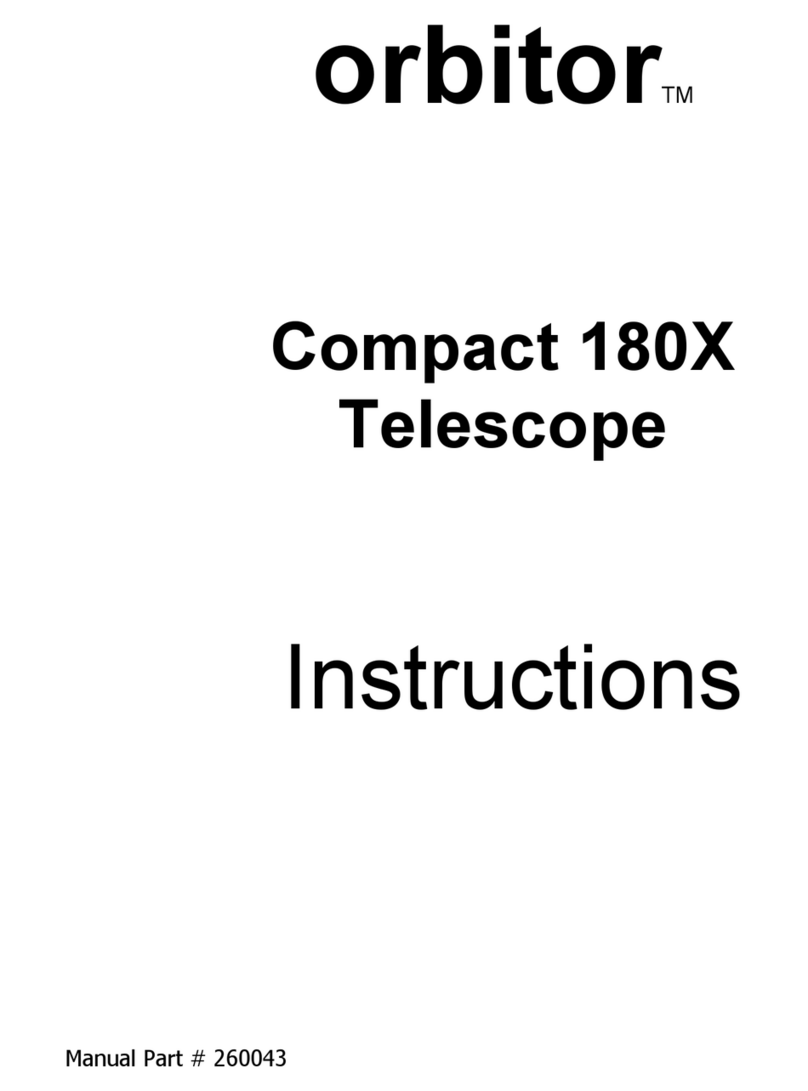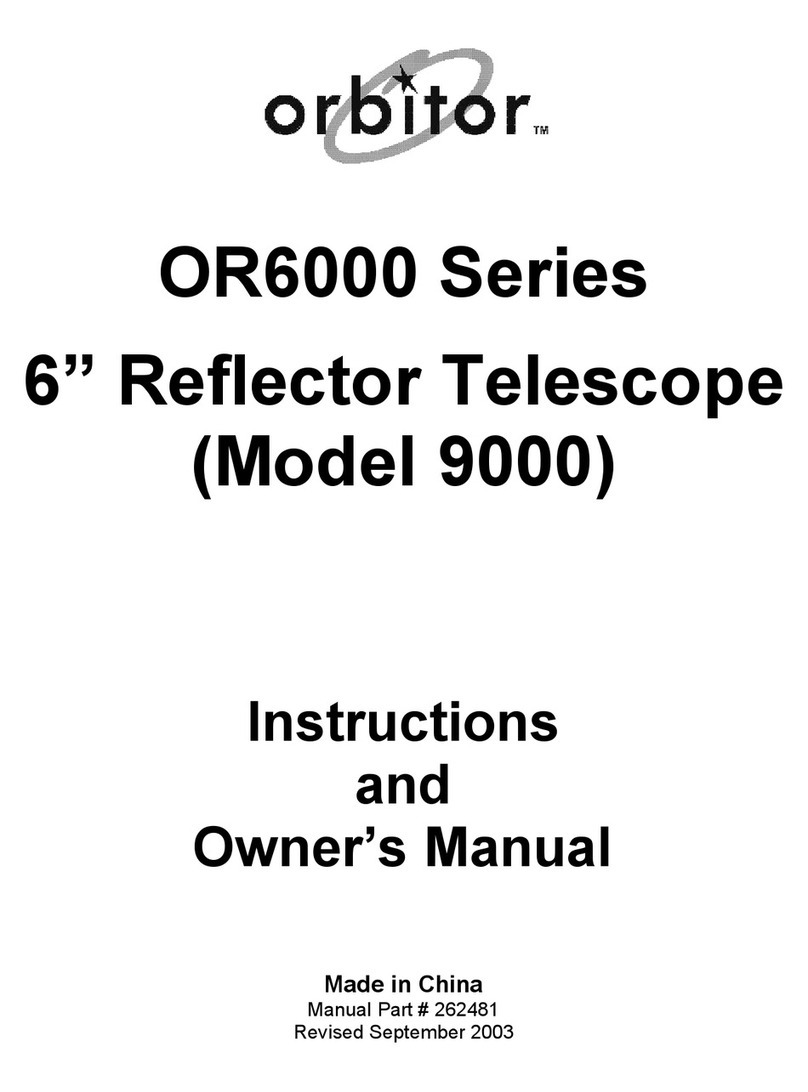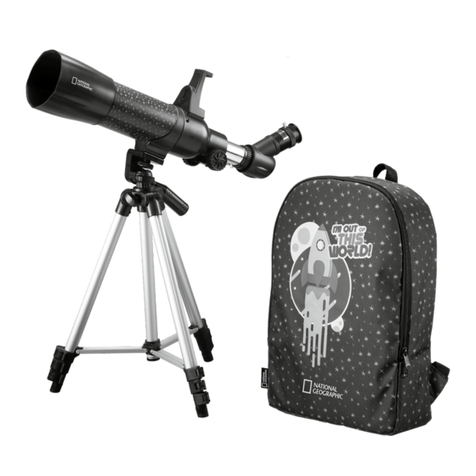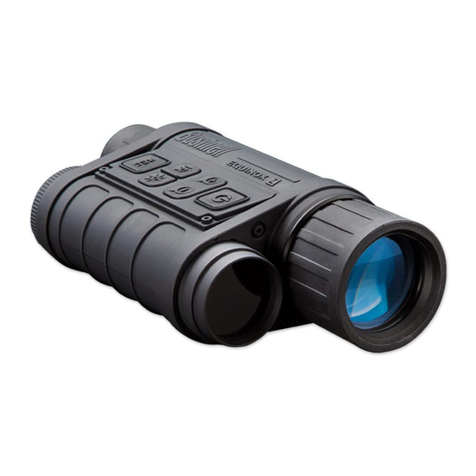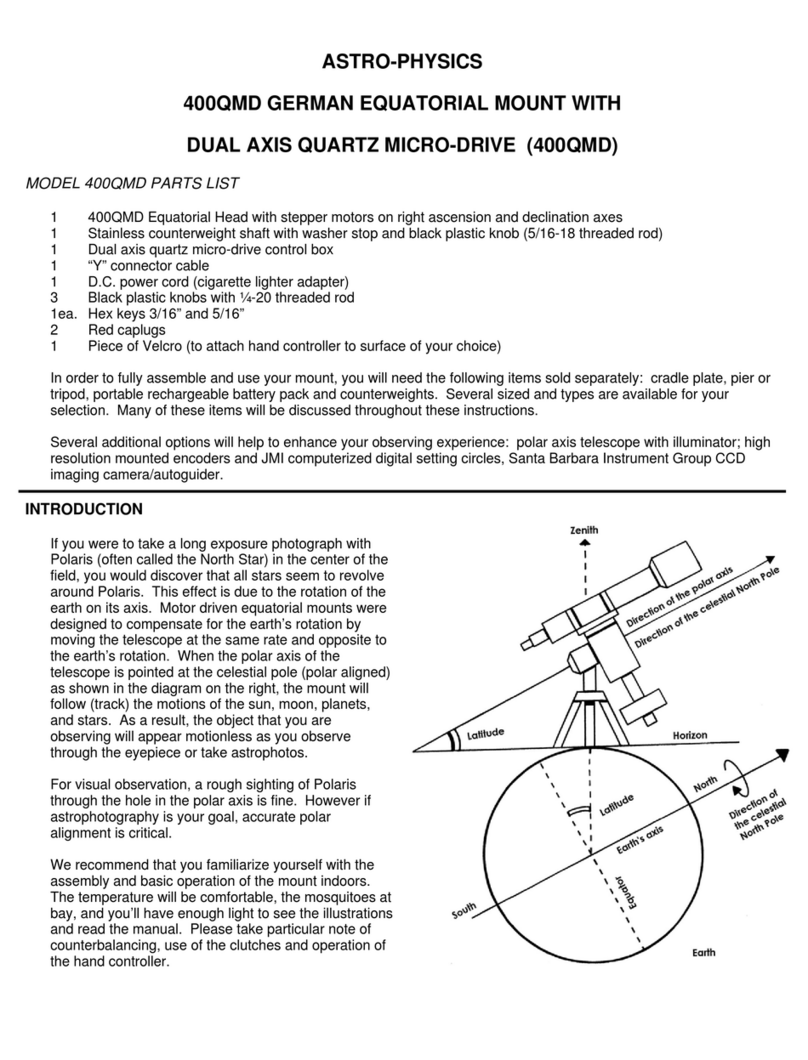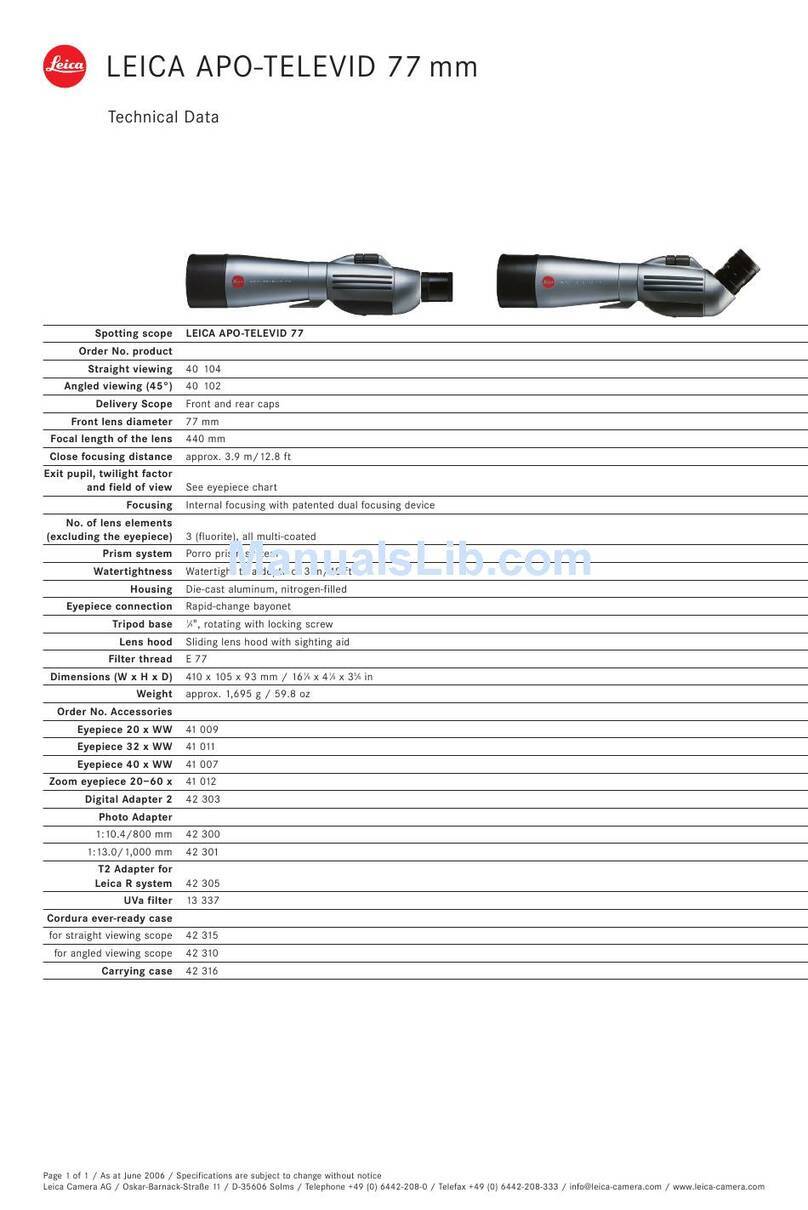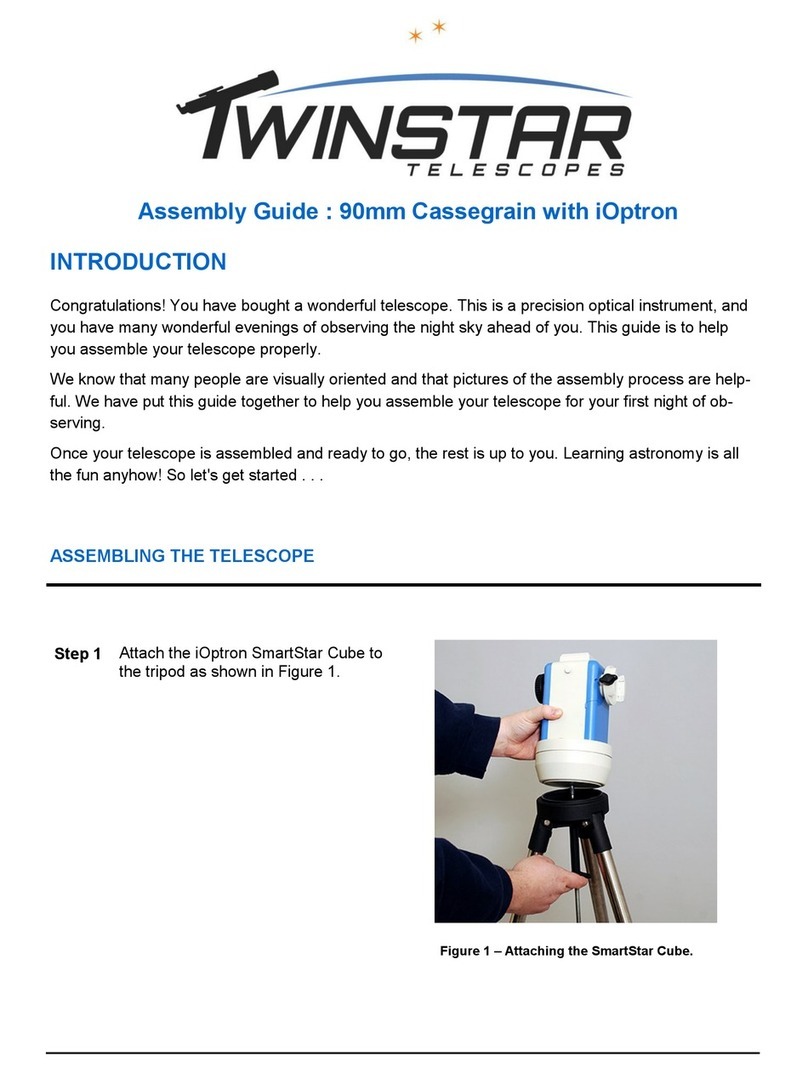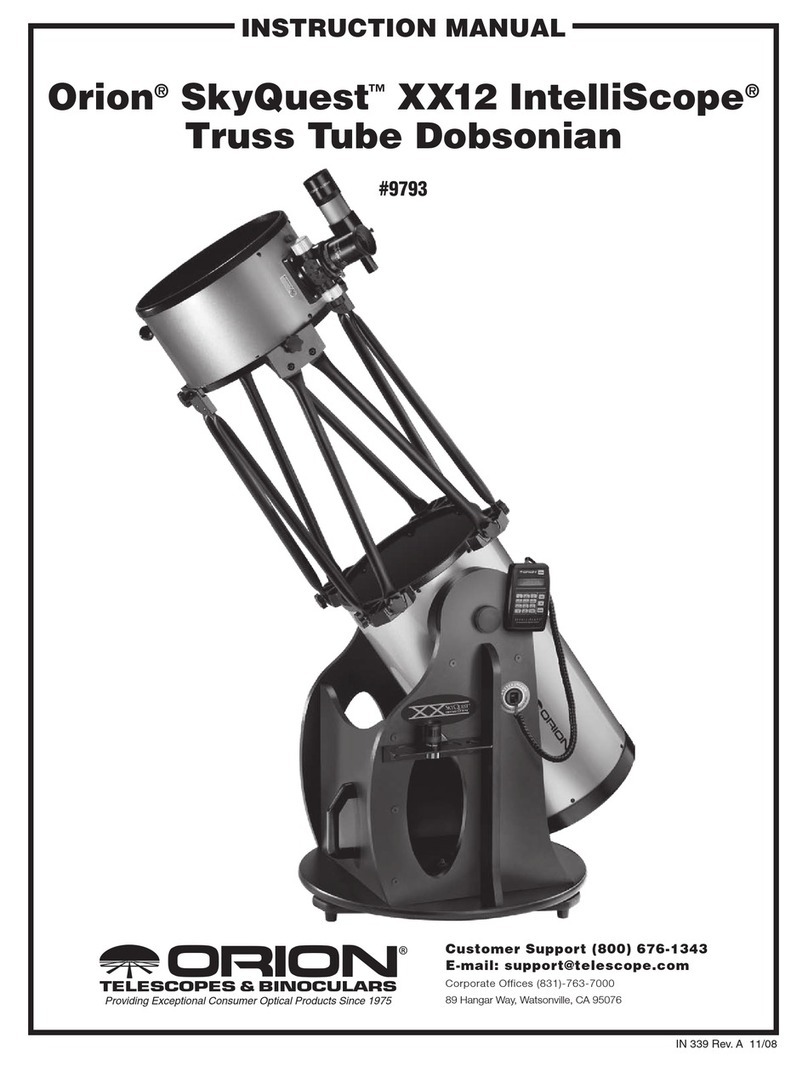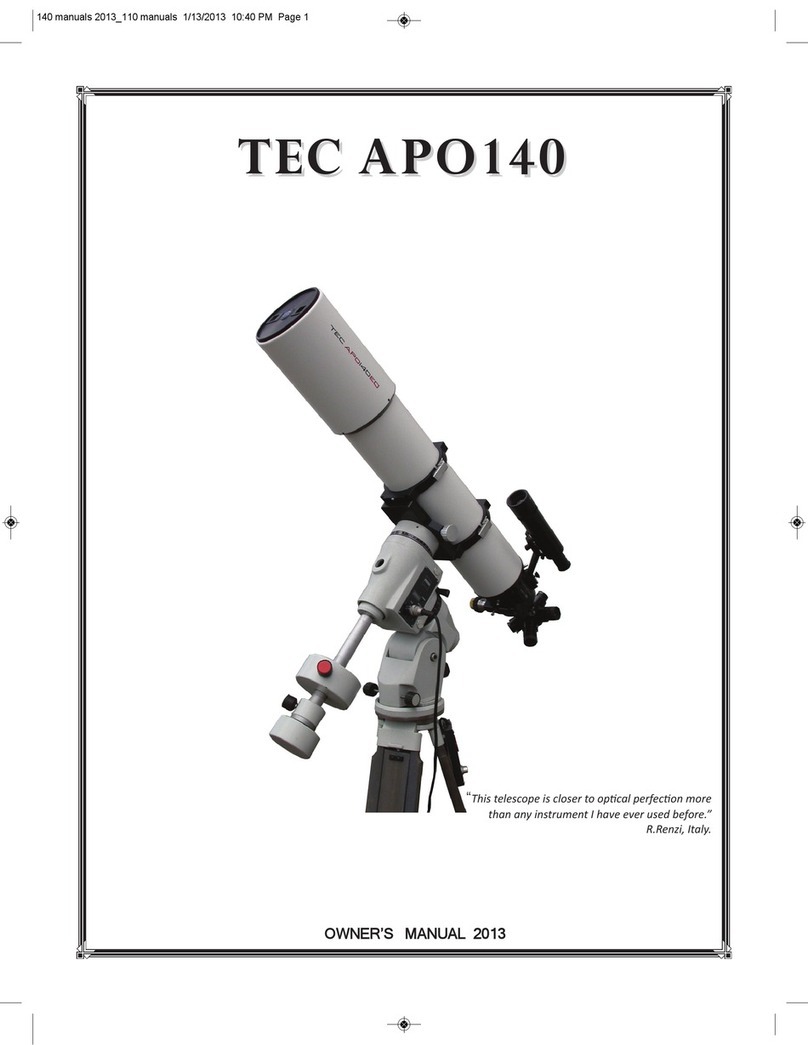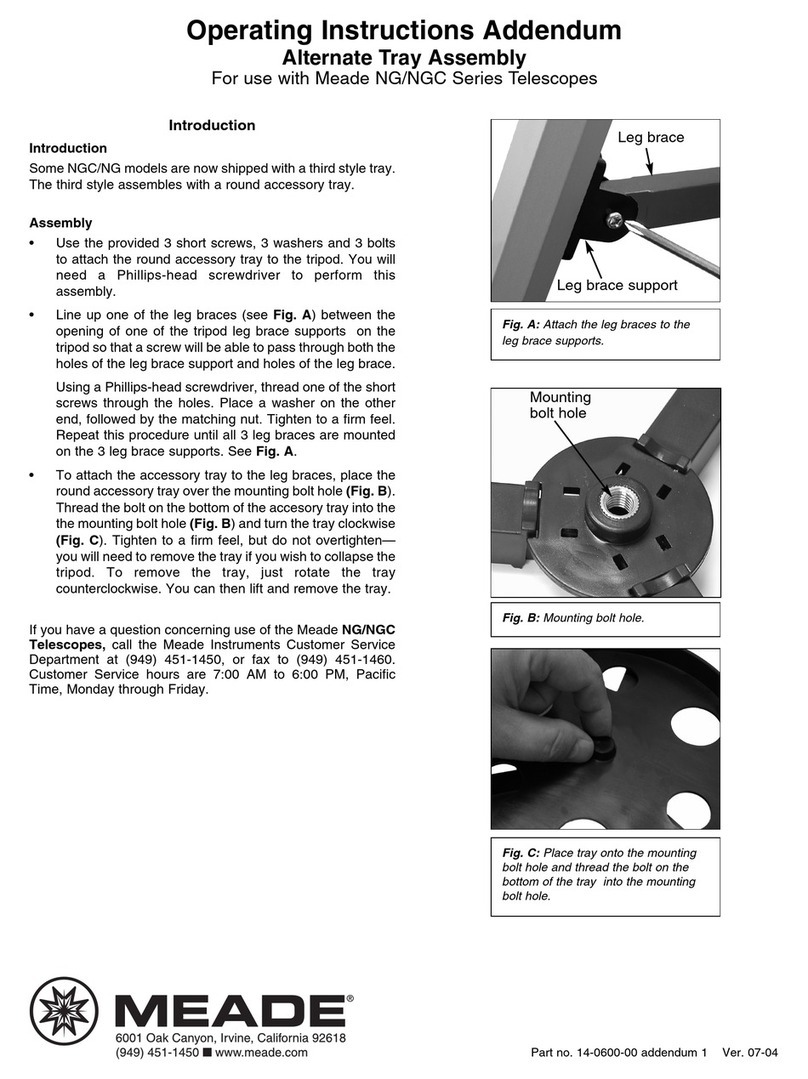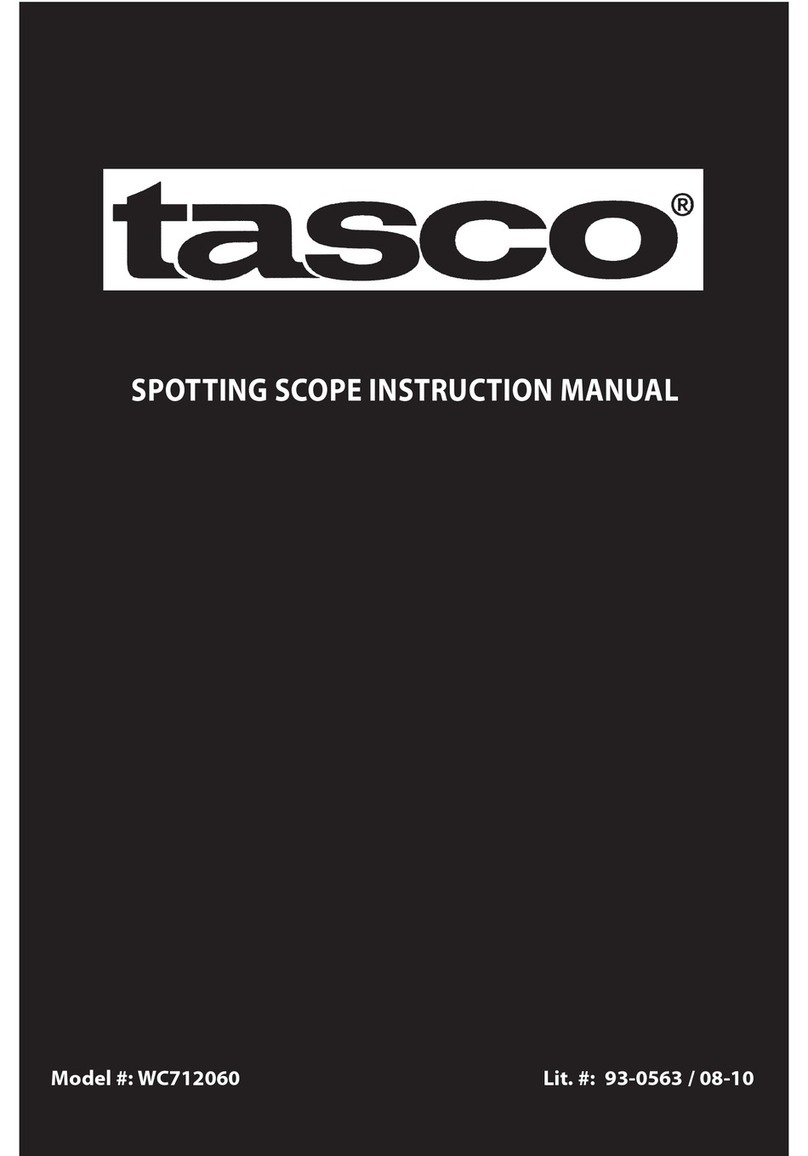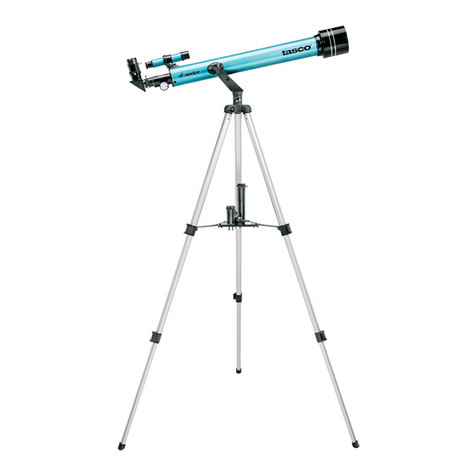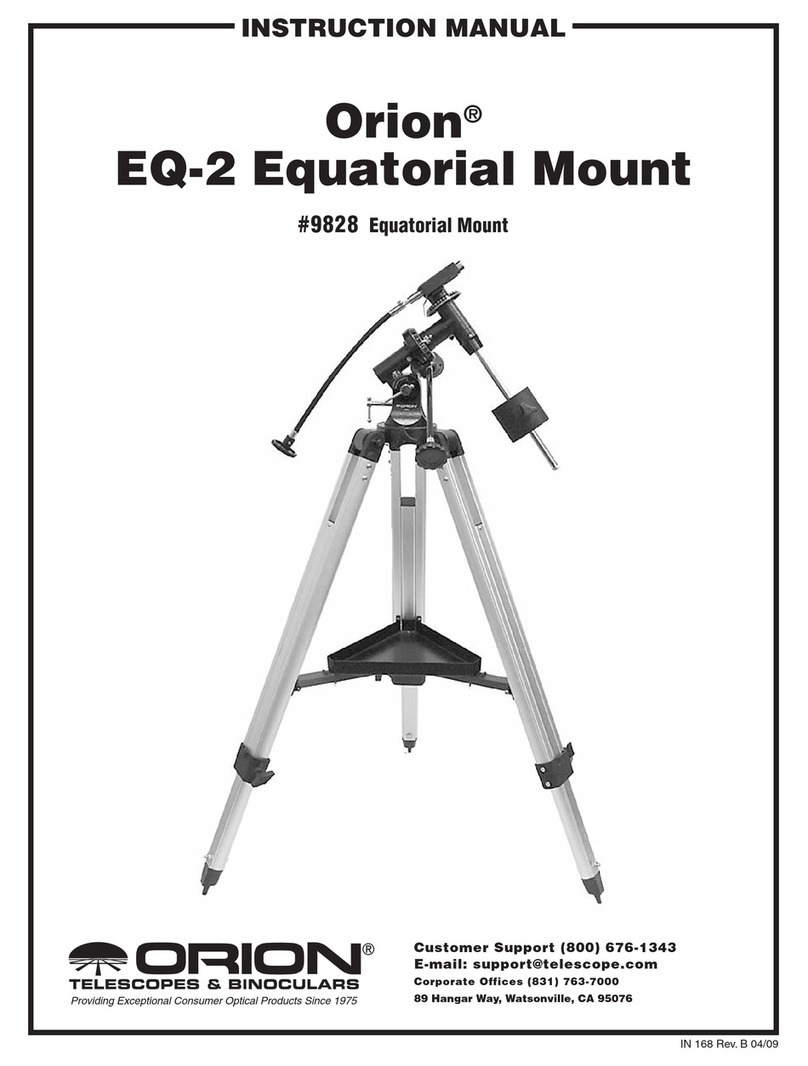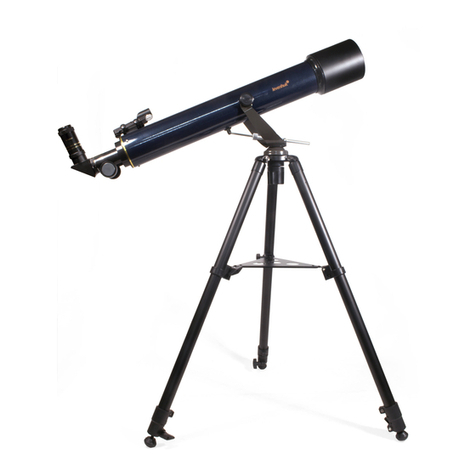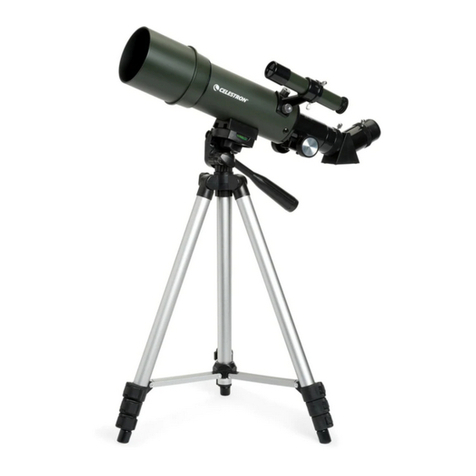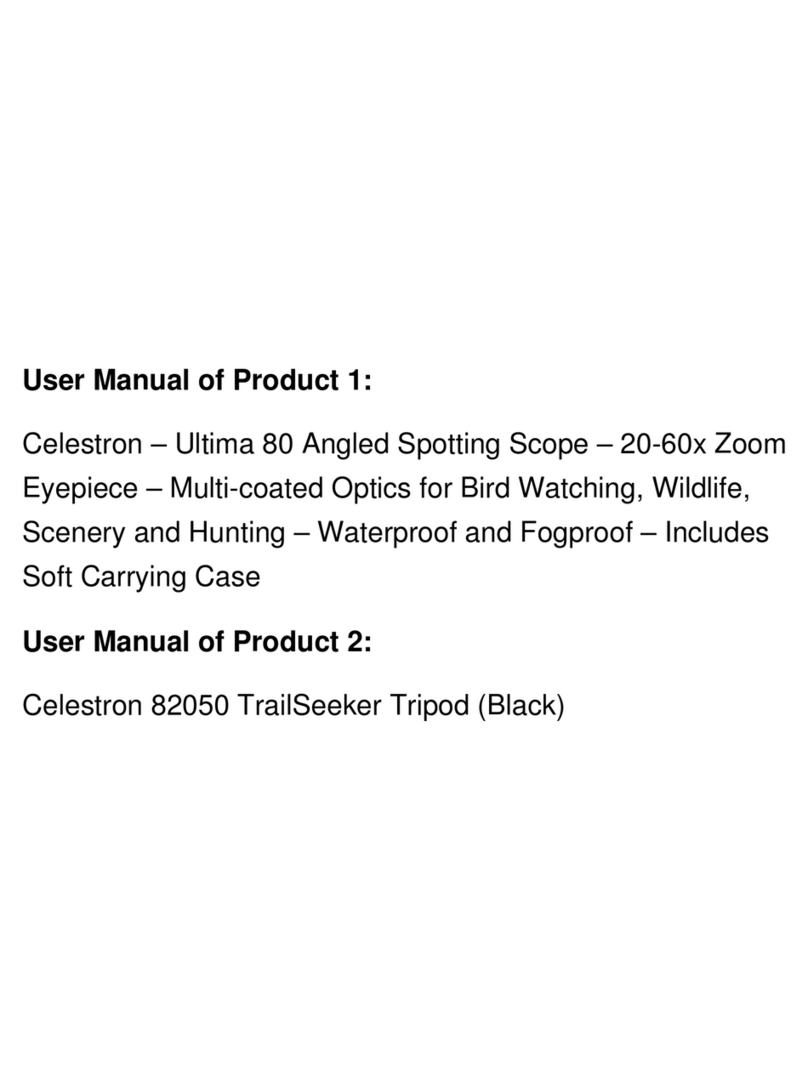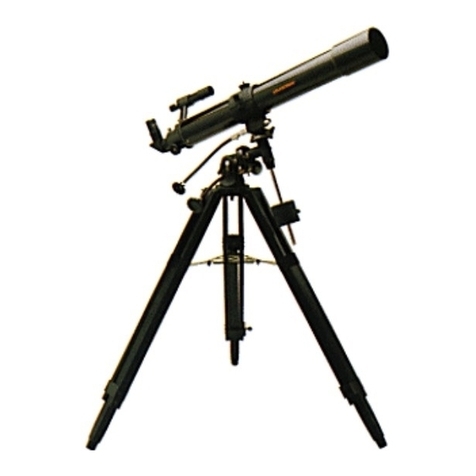Citiwell Orbitor OR7500 Quick start guide

OR6000 Series
4.5” Reflector Telescope
(Model 7500)
Instructions
and
Owner’s Manual
Made in China
Manual Part # 262504
Revised September 2003

2
WARNING!
NEVER aim your telescope at the sun or even close to the sun!
Instant and irreversible damage can occur,
including blindness!
Do not let children use any telescope without adult supervision.
NOTE: Actual parts and components may vary slightly in color or style from
pictures shown.
A. Finder scope and bracket
B. Slow-motion controls (2)
C. Equatorial motor
D. Battery pack & cord
E. Counterweight shaft
F. Tripod leg bolts (3)
G. Tripod leg brace hub
H. Tripod leg brace bolts
I. Equatorial mount assembly
(with cradle rings attached)
J. Counterweight
K. Accessory tray
L. Accessory tray screws (3)
M. 2X Barlow lens
N. Eyepieces (2)
O. Optical tube
P. Tripod leg (3)
Parts of your new telescope:
A
B
C
D
E
F
G H
I
J
K
L
M
N
O
P
WARNING!
CHOKING HAZARD
Small parts. Not suitable for
children under 3 years.
!

3
Introduction
Congratulations on your purchase of a new OR7500 telescope. With proper care and
handling of your telescope, you will enjoy the pleasure of looking at nature’s wondrous
sights through the eye of this instrument for many years.
Your telescope has been designed to provide views of the moon’s craters, Jupiter’s
major moons, and Saturn’s rings, in addition to dozens of galaxies, star clusters, and
nebulae.
To obtain the best performance from your telescope, please read this manual carefully
and completely.
FOR MORE INFORMATION AND ANSWERS TO ANY QUESTIONS, PLEASE GO TO
OUR WEBSITE: www.citiwellint.com
NOTE: When you remove the cradle rings and the protective plastic bag from the
telescope tube there may be a residue on the tube. To remove this residue use a warm,
soapy cloth and carefully clean the area, being careful not to let water enter the tube.
Dry completely with a soft towel and then buff with a soft cloth. You may polish the tube
with a good quality spray wax. Do not spray the wax directly onto the tube. Spray it
lightly on the polishing cloth. Do not use excessive force as scratches may result.

4
ASSEMBLY
1) Carefully remove all parts from the cardboard cartons and lay them on a table or
on the floor in order to take an inventory of all the pieces. Keep your box for storage
or in case you ever need to ship your telescope.
2) Extend the tripod legs, and lock each one at the desired height with the tripod leg
adjustment knobs. (See Fig. 1)
(Fig. 1)
3) If your tripod is not fully assembled you need to attach the tripod braces (attached
to each leg) to the tripod leg brace hub using the 3 thin bolts with nuts. (See Fig. 2A)
The completed assembly is shown in Figure 2b. Then attach each leg to the
equatorial mount assembly with supplied tripod leg bolts and wing nuts. (See Fig. 2)
(Note that some telescopes may have round plastic tighteners in place of wing nuts.)
(Fig. 2a) (Fig. 2b) (Fig. 2c)
4) Locate the tray attachment bolt (Fig. 3). Dis-assemble it as shown in Figure 3a by
turning the round knob counter-clockwise. Insert the chrome shaft upward through
the center of the tripod leg braces and up through the hole in the center of the
triangle-shaped accessory tray. While holding the shaft in place from underneath,
place the crinkly spring washer and the larger solid metal washer over the shaft as
shown in Figure 4. Then place the round knob over the shaft and turn clockwise until
tight. (See Fig. 4a)
(Fig. 3) (Fig. 3a) (Fig. 4) (Fig. 4a)

5
5) If your equatorial mount assembly does not have the cradle rings attached, you need
to attach the cradle rings to the equatorial mount assembly base with the bolts as
shown in Fig. 5.
(Fig. 5)
6) Open the cradle rings and place the optical tube inside. Close the rings around the
optical tube and tighten the bolts to hold the optical tube in place. Make sure the tube
is positioned and facing the same direction as in the illustration. (See Fig. 6 and 7)
(Fig. 6) (Fig. 7)
7) The counterweight balances your telescope and makes it easy to adjust and
position. Hold the counterweight in your hand so you can see through the hole in the
weight. Make sure that the black tightening knob on the counterweight is facing
down. If when you look through the counterweight you see that the hole is blocked by
a small metal rod, slowly turn the tightening knob counterclockwise to loosen it until
you see that the hole is clear. Insert the counterweight shaft through the
counterweight and attach and tighten the screw at the end of the shaft. Then turn the
counterweight tightening knob clockwise to secure it. (See Fig. 8 and 9)
(Fig. 8) (Fig. 9)

6
8) Insert the threaded end of the counterweight shaft into the equatorial mount and
turn it clockwise until it stops. (See Fig. 10 and 11)
(Fig. 10) (Fig. 11)
9) Attach a slow-motion control knob to the right ascension shaft as shown in Fig. 12.
Tighten the small knob on the slow-motion control until it is tight against the flat side
of the right ascension shaft. Attach the other slow-motion control to the declination
shaft as shown in Fig. 13 and tighten it into position. Fig. 14 shows the completed
assembly.
(Fig. 12) (Fig. 13) (Fig. 14)
10) Remove the finder scope (with attached bracket) from the box. Slide the finder
scope bracket into the finder scope base on the telescope. (See Fig. 15) Apply a
gentle pressure until the finder scope bracket is firmly secured to the mount. (See
Fig. 16)
(Fig. 15) (Fig. 16)

7
11) Insert the 25-mm eyepiece into the eyepiece holder. (See Fig. 17) Tighten the
small set screw to hold the eyepiece securely in place.
(Fig.17)
12) A 2X Barlow lens is supplied to double the basic magnifying power provided by
an eyepiece. In viewing situations where very high magnifying powers are desired,
insert the 2X Barlow lens between the eyepiece and the focusing tube. (See Fig. 18)
(Fig. 18)
13) The equatorial motor supplied with the OR7500 is designed to provide accurate
tracking of celestial objects along the RA (Right Ascension) axis, thereby reducing
the need for making constant manual readjustments in order to follow and keep a
subject in view. Attach the motor to the mount assembly by first attaching one end of
the spring to the screw on the mount (the other end should already be attached to the
motor). (See Fig. 19 and 20).
(Fig. 19) (Fig. 20)

8
14) With the spring now connected to both the motor and the equatorial mount, attach
the motor to the mount by placing the chromed collar over the shaft on the mount and
tighten the locking screw. (See Fig. 21)
(Fig. 21) (Fig. 21a)
15) The motor has a chromed lever that engages and disengages the clutch, providing
a simple way of controlling the motorized operation of the telescope. Place the
ON/OFF switch in the ON position, indicated by a green light (See Fig. 21a) With the
power switch ‘ON’, move the lever to the ‘engaged’ position (See Fig. 22) to connect
the motor to the RA axis of the telescope’s equatorial mount and begin motorized
tracking. Move the lever to the ‘disengaged’ position (See Fig. 23) to disconnect the
motor and stop motorized tracking. THE MOTOR MUST BE DIS-ENGAGED BEFORE
MANUALLY ADJUSTING THE R/A AXIS SLOW MOTION CONTROL.
(Fig. 22) (Fig. 23)
16) The motor is powered by 4 ‘D’ size batteries, housed in the battery pack supplied
with your OR7500. To install the batteries, remove the power pack from its case as
shown in Fig. 24. Open the battery cover and insert the batteries in the direction
indicated. (See Fig. 25) Close the cover and place the battery pack back into its case.
Connect the battery pack to the motor by plugging the cord into the motor. (See Fig. 26)
(Fig. 24) (Fig. 25) (Fig. 26)

9
FINDER SCOPE ALIGNMENT
Since a telescope has a narrow field of view by design, it can be challenging to locate a
particular star or planet. For this reason the telescope is fitted with a low-power, wide-
field miniature telescope called a finder scope. Always use your finder scope to locate
the object you want to view FIRST. The finder scope should be aligned with the
main telescope tube before you begin using the telescope, in order that both
scopes are positioned to always provide exactly the same angle and view.
Note: Objects in the finder scope are upside down. This is normal and is common to all
astronomical telescopes.
Complete the following settings in daylight: WITH THE EQUATORIAL MOTOR
TURNED ‘OFF’ AND CLUTCH DISENGAGED.
1) Insert the 25-mm eyepiece into the eyepiece holder. Look at an easily recognizable,
stationary object that is at least 300 feet away. Slightly loosen all locking knobs and
move the telescope BY HAND until the object is in the center of the field of view. Then
bring the image into focus.
2) Firmly retighten the locking knobs so that the telescope is locked in position.
3) Look through the finder scope. If the object is not visible or centered in the finder
scope, simply release one of the three small adjusting screws holding the finder scope
and reposition the finder scope until the object is centered within the X-shaped
crosshairs.
4) All screws should be completely tightened as soon as the view through the finder
scope coincides with the view of the main telescope.
5) This procedure may need to be repeated to ensure a perfect alignment.
THE EQUATORIAL MOUNT
The advanced, precision-engineered equatorial mount on the OR7500 moves the main
optical tube in a circular fashion. This is very important because it means that you can
set up your telescope to conveniently compensate for the rotation of the Earth, and
easily follow celestial objects and planets in their natural path or orbit in the night sky.
When you observe an astronomical subject through a telescope it will appear to move
across the viewing area. At medium-power magnifications the image can appear to
move across the whole viewing area in about 30 seconds. With a simple mounting
system, called an altazimuth mount, it can be difficult and frustrating to track an object
and keep it in view. The equatorial mount simplifies this operation, but it must be
correctly set up.
Pick up and rotate the whole telescope until the front of the main optical unit is facing
north. Look fairly high in the sky until you see the familiar star grouping called the Big
Dipper. By following an imaginary line up from the two end stars of the dipper (the

10
“pointers”), you will come to a single star with no other stars close by. This is Polaris, or
the North Star. Loosen the altitude adjustment and suppot knobs (See Fig. 27) and
raise or lower the angle of the telescope until you can see Polaris centered in the finder
scope. Be certain that your finder scope is properly aligned.
Altitude adjustment
and support knobs
(Fig. 27)
You can also adjust the declination by raising or lowering the angle of the main optical
unit until the arrow on the degree scale located on the side of the equatorial mount
points toward the north latitude of your observing location. If you do not know your
viewing position’s north latitude, you can call a local weather office or airport to find out.
Use your finder scope to locate an object. Focus on the object and begin observing. As
you notice the viewed object move across the viewing area slowly turn the slow-motion
cable extending from the left side of the telescope until the object is centered again. If
your setup was not accurate you will notice that the subject is moving very slowly either
up or down. A slight turn of the declination slow-motion control knob extending from the
back of the telescope will counteract this slight error. (See Fig. 13)
FOR A MORE COMPLETE EXPLANATION OF POLAR ALIGNMENT OF AN
EQUATORIAL MOUNT, PLEASE VISIT THE “FAQ” SECTION OF OUR WEBSITE;
www.citiwellint.com
ABOUT MAGNIFICATION
The magnification power of a telescope indicates how much an image is enlarged or
how big and close it appears to the viewer. The focal length of the eyepiece, combined
with the focal length of the telescope, determines the magnification power. To calculate
the power of your telescope with any particular eyepiece, simply divide the focal length
of the telescope (900 mm) by the focal length of the eyepiece (indicated in “mm” on the
eyepiece collar).
Example: 900-mm focal length (tube) = 36X magnification power
25-mm focal length (eyepiece)

11
The following magnification values are achieved when using the Barlow lens and the
interchangeable eyepieces:
Eyepiece Power Power With 2X Barlow Lens
25 mm 36X 72X
6 mm 150X 300X
The level of magnification required depends on the object being observed. Optimal
performance is obtained if the magnification is typically not more than about 30X for
every 10 mm of objective lens diameter. Magnification of around 335X or less is ideal
for a telescope with a 114-mm diameter objective lens and is best for observing most
celestial objects. A lower magnification power and a wider field of view are advisable for
observing galaxies and nebulae. The highest magnification power should be used for
detailed observations of the moon, Jupiter, Saturn or any object that is quite bright.
The highest magnification power of the Barlow lens/6-mm eyepiece combination should
only be used for large or bright objects such as the moon and the brightest planets.
ABOUT YOUR NEWTONIAN REFLECTOR TELESCOPE
Your telescope is a Newtonian reflector. Light enters the open end of the tube and
travels down to the opposite end where it strikes a specially curved mirror, known as the
primary mirror. The focused image is reflected back up the tube to a small, flat mirror
near the open tube end, called the secondary mirror. This secondary mirror reflects the
focused image out through the side of the telescope tube to the
eyepiece holder where it is enlarged for viewing through the
eyepiece.
The primary mirror is a precision ground and polished
component that is precisely positioned at one end of the optical
tube. It is pre-aligned for maximum peformance at the factory
and should not need any adjustment. Therefore, never adjust
or remove any of the screws located at this end of the
optical tube. Doing so will void your warranty and degrade
the performance of your telescope. (See Fig. 28)
(Fig. 28)
USING YOUR TELESCOPE
1) Take your telescope outside. Viewing objects through closed or open windows is not
recommended. Your view can be distorted by reflections in the glass of a closed
window or by air currents of differing temperatures passing through an open window.
2) Let your telescope adjust to the outside temperature. Your telescope will perform
much better if the temperature of the mirrors, eyepiece lenses, and the air inside the
tube are the same as the outside temperature. It may take up to 30 minutes to
equalize the temperatures when the difference in temperatures is extreme.

12
3) Find a location far from glaring light. If you live in an urban area, your viewing will
probably improve the farther you move away from the city lights. The sky glow of a
town or city can dramatically reduce the telescope’s performance and viewing
capabilities.
4) Remove the dust cap from the end of the telescope nearest the eyepiece holder and
the finder scope. The dust cap consists of two pieces—a small, removable piece and
the large main cap. (See Fig. 29) Both pieces should be removed. (See Fig. 30) The
open end of the optical tube is pointed toward the subject you wish to observe. Your
dust cap may have two smaller openings instead of one. This is of no concern.
(Fig. 29) (Fig. 30)
5) Begin your viewing session by using the 25-mm eyepiece by itself. It will give you
the widest angle and the brightest, sharpest views.
When possible, avoid sudden temperature changes, as the moisture in the air will
condense on the mirrors and eyepiece lenses. Should this occur after bringing your
telescope inside, remove the dust caps and allow the moisture to evaporate naturally.
Point the telescope downward to minimize the collection of airborne dust. Once all of
the moisture has evaporated, replace the dust caps.
CARE AND CLEANING OF OPTICS
Optical components of a telescope get dirty over time. Dirt or dust on a lens should be
removed with the utmost care. A considerable amount of dirt or dust would have to
accumulate on the optical surface before your view would be compromised.
1) Keeping dust caps on during storage and transport will reduce dust collection.
2) Condensation may collect on the optical surfaces when the telescope is not in use.
Remove the dust caps and allow the moisture to evaporate naturally. Point the
telescope downward to minimize the accumulation of airborne dust.
3) Once all moisture has evaporated, replace the dust caps.
4) Filtered, compressed air may be used to remove surface dust from lenses and
mirrors. Remove the dust cap and the dew shield. Once removed, point the can away
from the lens and gently expel some air and any condensation or dust that has
accumulated on the discharge tube. Spray the lens or mirror with short bursts of air to

13
carefully remove the dust particles. DO NOT HOLD THE TRIGGER OF THE
COMPRESSED AIR CAN FOR EXTENDED PERIODS BECAUSE PROPELLANT
FROM THE CAN MIGHT ESCAPE AND DAMAGE THE OPTICAL SURFACE.
If, after several attempts, you cannot remove the particles, take the telescope to an
optical professional for cleaning.
If you keep the dust caps on your telescope when it is not in use and avoid handling the
lenses or mirrors, only minimal optical maintenance of your telescope should be
required. Extensive cleaning is usually only necessary every few years.
WHAT TO LOOK FOR IN THE NIGHT SKY
There is a whole universe of objects you could view at night, so where do you start?
We recommend starting with the most prominent objects first.
The moon
The moon is the easiest target to find at night. When the moon is in full position, it
bathes the night with a silvery light that washes the sky of all but the brightest objects.
The best time to view the moon is not when it is full, but rather when it is less than half
full. The dividing line between dark and light on the moon, called the terminator, shows
the best detail in the craters and mountains.
The planets
The planets, our solar system companions, range in size and substance from moon-size
rocky bodies to giant gas balls, which could hold Earth 1,000 times over. To find the
planets, you will need information about their times of visibility. An astronomy magazine
will give you the locations of the planets as they change position from month to month.
The Internet is also an excellent source of information, offering star charts, maps, and
more!
The popular and more familiar constellations often provide the easiest landmarks to
help find the planet’s locations and paths of orbit. Most people have looked up at the
sky at night and seen some of the planets without even realizing it. A planet looks like a
bright star but does not twinkle like a star does; it looks like a tiny ball. Venus, Mars,
Jupiter, and Saturn are the easiest planets to view. Mercury is dimmer, usually below
the horizon, and more challenging to find.
Each of the planets provides interesting views. Venus is covered with clouds so all that
is visible is an extremely bright light, the brightest next to the moon. However, Venus,
like the moon, goes through phases. As it travels around the sun, different areas of its
surface are illuminated, producing crescent shapes of varying sizes. Mars is the red
planet. When it is above the horizon, it is noticeably red and stands out like a beacon in
the night sky. The apparent brightness of Mars varies as the planet orbits around the
sun and throughout its period of visiblity, it will look brighter or dimmer depending on its
distance from Earth.

14
Jupiter is the largest planet in our solar system and the second brightest next to Venus.
Jupiter has many moons, four of which are often visible through your telescope when
viewing conditions permit. As you watch them throughout the evening, you will see that
they change position relative to each other and to Jupiter. It is possible with careful
planning to actually see one of the moons disappear either in front of or behind Jupiter
as it orbits around the planet. Another great feature of Jupiter is its cloud belt.
Jupiter is alive with weather activity and its clouds have formed over time into belts
visible through telescopes in the right atmospheric conditions.
Saturn, the second largest planet, is not as bright as Jupiter and so its moons are not as
visible through small telescopes. The large rings that encircle Saturn are spectacular to
observe, however. The planet and its rings appear pale yellow. The major division in the
rings, the Cassini division, is possible to see if you keep the telescope firmly in position.
Uranus and Neptune are the last of the solar system’s gas giants. They do not provide
as spectacular a sight as Jupiter or Saturn, but are nonetheless rewarding to see.
Beyond our solar system there are many more objects to be found. Galaxies, nebulae,
and star clusters abound!
FREQUENTLY ASKED QUESTIONS
1) How far can I see?
If you stand outside and look up at the night sky on a clear evening, you can see
hundreds of stars without the aid of your telescope. The telescope is a light-gathering
instrument that magnifies the view—providing significantly more detail and unveiling
more stars, nebulae, and celestial objects. With the aid of a telescope, you will be able
to enjoy exciting views of Saturn’s rings, Jupiter’s major moons, the Orion Nebula, and
much more.
2) Why can’t I see anything through my telescope?
If you see only gray or black when looking through your telescope, even after searching
for an object to view, it is very likely that you are using an eyepiece that is too powerful.
To solve this problem always start with the lowest power eyepiece first, and only insert
the higher-power eyepiece after you have located an object.
3) When I use my high-power eyepiece, everything looks much darker. Why?
As magnification in a telescope increases, brightness diminishes. Conversely,
brightness increases when magnification is reduced. If an image appears too dark or
unclear, use a lower-powered eyepiece. Views of small, bright objects are superior to
those of large, dark, or blurry ones! Atmospheric conditions, air currents, as well as light
and air pollution also affect viewing quality.

15
4) As I look through my telescope, objects in the sky appear to move. Why is
that?
When you observe an astronomical subject through a telescope, the constant rotation of
the Earth makes things appear as though they are moving across the viewing area. The
equatorial mount provided with your telescope compensates for this by moving the main
optical tube in a circular fashion, allowing you to follow and study celestial objects with a
minumium of manual adjusting. If you would like to reduce this effect of movement to a
minimum and observe the widest field of view, you should use lower-power eyepieces.

16
Please Read this Important
Notice!
The aiming point of your new telescope can be either MANUALLY
controlled or ELECTRONICALLY controlled.
This function is controlled by a small switch
located on the equatorial motor. (See page 8 in
your instruction manual).
To turn on the MANUAL control function, set
the small slide switch to the “ON” position and
disengage the clutch, as described in your
manual.
To switch to the ELECTRONIC control function, you can turn the
MANUAL control function off by engaging the clutch and setting
the switch to the “OFF” position. A green light will indicate that
the motor is working properly.
If the green light does not light up, it is probably an indication
that the batteries in motor’s battery pack need replacing, or that
the battery pack is not plugged into the motor.
This manual suits for next models
1
Table of contents
Other Citiwell Telescope manuals
